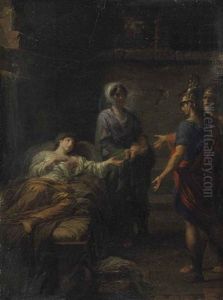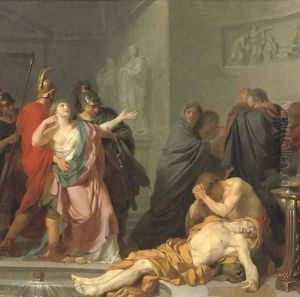Jean Charles Nicaise Perrin Paintings
Jean Charles Nicaise Perrin was a prominent French painter and engraver born in 1754 in Strasbourg, France. His artistic journey began under the tutelage of notable artists in his hometown, which laid a solid foundation for his future career. Perrin's work is often characterized by its classical influences and adherence to the academic standards of his time, which was heavily dominated by the Neoclassical movement.
Perrin's career flourished during a tumultuous period in French history that encompassed the end of the Ancien Régime, the French Revolution, and the Napoleonic era. Despite the political upheavals, he managed to gain recognition and patronage. His artistry was not only confined to painting; he was also skilled in engraving, a talent that allowed him to reproduce his works and those of others, thus broadening his influence.
Throughout his career, Perrin exhibited at the prestigious Paris Salon, where he received accolades for his mastery in painting. His subjects varied from historical scenes and portraits to mythological themes, showcasing his versatility and deep understanding of classical art. Perrin's work was appreciated for its precision, attention to detail, and the ability to convey emotion, capturing the essence of the Neoclassical movement's ideals.
Jean Charles Nicaise Perrin's contributions to French art were recognized with his admission to the Legion of Honour, an accolade that underscored his significance in the country's artistic heritage. His legacy is preserved through his works housed in various museums and collections around the world, standing as a testament to his skill and dedication to the arts.
Perrin passed away in 1839, leaving behind a body of work that continues to be studied and admired. His life and career reflected the complexities and transitions of his time, marking him as a key figure in the history of French Neoclassical art.
![Portrait De Femme Avec Un Chale [ ; Portrait Of A Woman With A Shawl ; Signed Lower Right J. Perrin ; Oil On Canvas]](https://www.niceartgallery.com/imgs/892940/s/jean-charles-nicaise-perrin-portrait-de-femme-avec-un-chale-portrait-of-a-woman-with-a-shawl-signed-lower-right-j-perrin-oil-on-canvas-2bd7d23a.jpg)

















